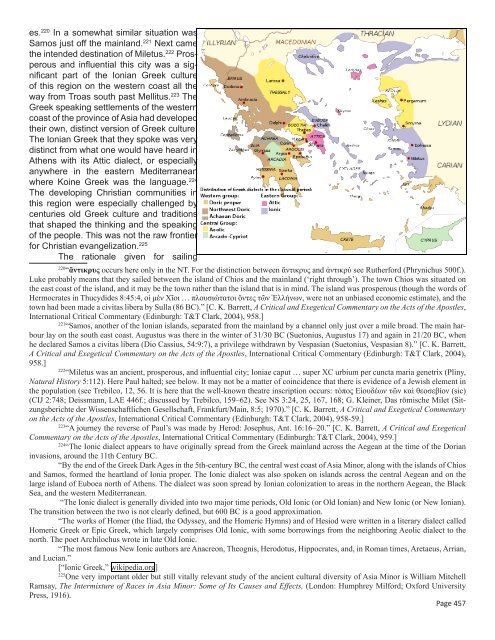3rd Missionary Trip - Lorin
3rd Missionary Trip - Lorin
3rd Missionary Trip - Lorin
You also want an ePaper? Increase the reach of your titles
YUMPU automatically turns print PDFs into web optimized ePapers that Google loves.
es. 220 In a somewhat similar situation was<br />
Samos just off the mainland. 221 Next came<br />
the intended destination of Miletus. 222 Prosperous<br />
and influential this city was a significant<br />
part of the Ionian Greek culture<br />
of this region on the western coast all the<br />
way from Troas south past Mellitus. 223 The<br />
Greek speaking settlements of the western<br />
coast of the province of Asia had developed<br />
their own, distinct version of Greek culture.<br />
The Ionian Greek that they spoke was very<br />
distinct from what one would have heard in<br />
Athens with its Attic dialect, or especially<br />
anywhere in the eastern Mediterranean<br />
where Koine Greek was the language. 224<br />
The developing Christian communities in<br />
this region were especially challenged by<br />
centuries old Greek culture and traditions<br />
that shaped the thinking and the speaking<br />
of the people. This was not the raw frontier<br />
for Christian evangelization. 225<br />
The rationale given for sailing<br />
220 “ἄντικρυς occurs here only in the NT. For the distinction between ἄντικρυς and ἀντικρύ see Rutherford (Phrynichus 500f.).<br />
Luke probably means that they sailed between the island of Chios and the mainland (‘right through’). The town Chios was situated on<br />
the east coast of the island, and it may be the town rather than the island that is in mind. The island was prosperous (though the words of<br />
Hermocrates in Thucydides 8:45:4, οἱ μὲν Χῖοι … πλουσιώτατοι ὄντες τῶν Ἑλλήνων, were not an unbiased economic estimate), and the<br />
town had been made a civitas libera by Sulla (86 BC).” [C. K. Barrett, A Critical and Exegetical Commentary on the Acts of the Apostles,<br />
International Critical Commentary (Edinburgh: T&T Clark, 2004), 958.]<br />
221 “Samos, another of the Ionian islands, separated from the mainland by a channel only just over a mile broad. The main harbour<br />
lay on the south east coast. Augustus was there in the winter of 31/30 BC (Suetonius, Augustus 17) and again in 21/20 BC, when<br />
he declared Samos a civitas libera (Dio Cassius, 54:9:7), a privilege withdrawn by Vespasian (Suetonius, Vespasian 8).” [C. K. Barrett,<br />
A Critical and Exegetical Commentary on the Acts of the Apostles, International Critical Commentary (Edinburgh: T&T Clark, 2004),<br />
958.]<br />
222 “Miletus was an ancient, prosperous, and influential city; Ioniae caput … super XC urbium per cuncta maria genetrix (Pliny,<br />
Natural History 5:112). Here Paul halted; see below. It may not be a matter of coincidence that there is evidence of a Jewish element in<br />
the population (see Trebilco, 12, 56. It is here that the well-known theatre inscription occurs: τόπος Εἰουδέων τῶν καὶ θεοσεβίον (sic)<br />
(CIJ 2:748; Deissmann, LAE 446f.; discussed by Trebilco, 159–62). See NS 3:24, 25, 167, 168; G. Kleiner, Das römische Milet (Sitzungsberichte<br />
der Wissenschaftlichen Gesellschaft, Frankfurt/Main, 8:5; 1970).” [C. K. Barrett, A Critical and Exegetical Commentary<br />
on the Acts of the Apostles, International Critical Commentary (Edinburgh: T&T Clark, 2004), 958-59.]<br />
223 “A journey the reverse of Paul’s was made by Herod: Josephus, Ant. 16:16–20.” [C. K. Barrett, A Critical and Exegetical<br />
Commentary on the Acts of the Apostles, International Critical Commentary (Edinburgh: T&T Clark, 2004), 959.]<br />
224 “The Ionic dialect appears to have originally spread from the Greek mainland across the Aegean at the time of the Dorian<br />
invasions, around the 11th Century BC.<br />
“By the end of the Greek Dark Ages in the 5th-century BC, the central west coast of Asia Minor, along with the islands of Chios<br />
and Samos, formed the heartland of Ionia proper. The Ionic dialect was also spoken on islands across the central Aegean and on the<br />
large island of Euboea north of Athens. The dialect was soon spread by Ionian colonization to areas in the northern Aegean, the Black<br />
Sea, and the western Mediterranean.<br />
“The Ionic dialect is generally divided into two major time periods, Old Ionic (or Old Ionian) and New Ionic (or New Ionian).<br />
The transition between the two is not clearly defined, but 600 BC is a good approximation.<br />
“The works of Homer (the Iliad, the Odyssey, and the Homeric Hymns) and of Hesiod were written in a literary dialect called<br />
Homeric Greek or Epic Greek, which largely comprises Old Ionic, with some borrowings from the neighboring Aeolic dialect to the<br />
north. The poet Archilochus wrote in late Old Ionic.<br />
“The most famous New Ionic authors are Anacreon, Theognis, Herodotus, Hippocrates, and, in Roman times, Aretaeus, Arrian,<br />
and Lucian.”<br />
[“Ionic Greek,” wikipedia.org]<br />
225One very important older but still vitally relevant study of the ancient cultural diversity of Asia Minor is William Mitchell<br />
Ramsay, The Intermixture of Races in Asia Minor: Some of Its Causes and Effects, (London: Humphrey Milford; Oxford University<br />
Press, 1916).<br />
Page 457

















